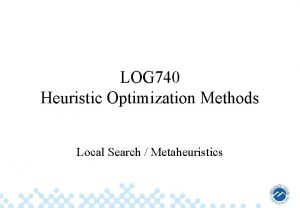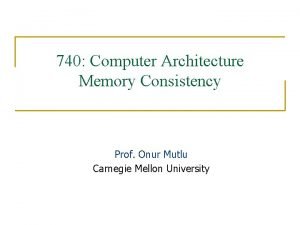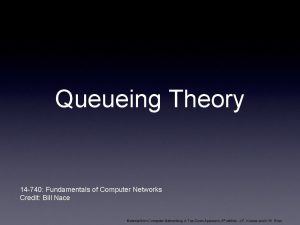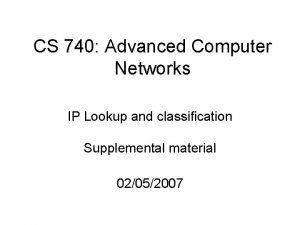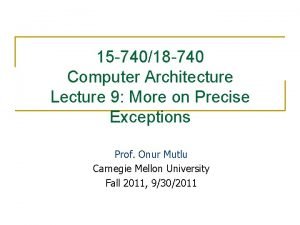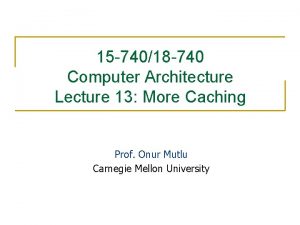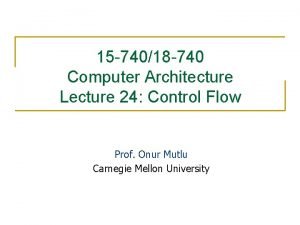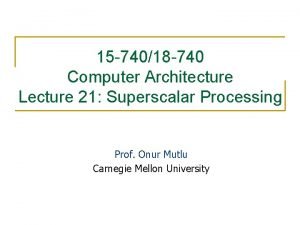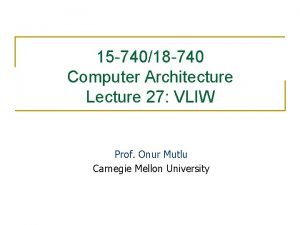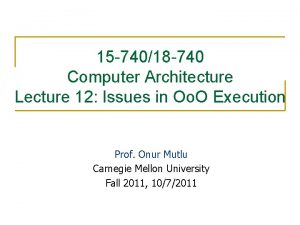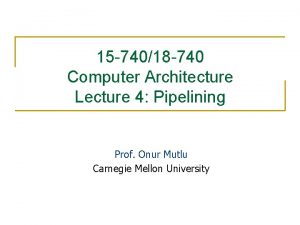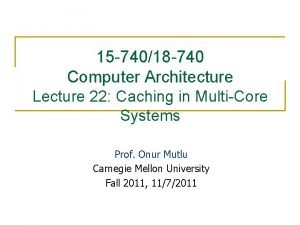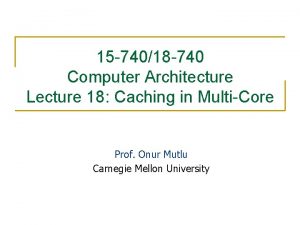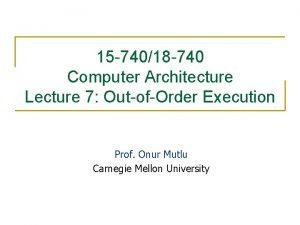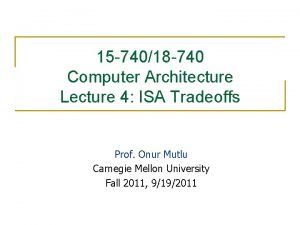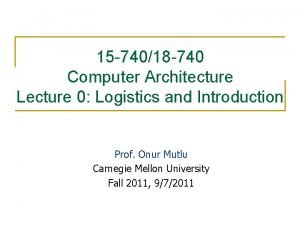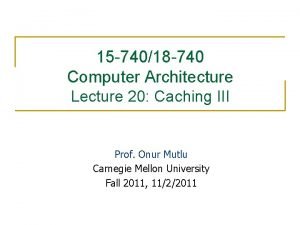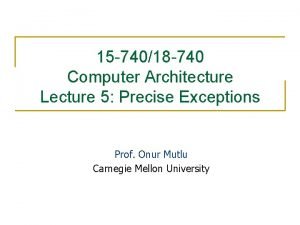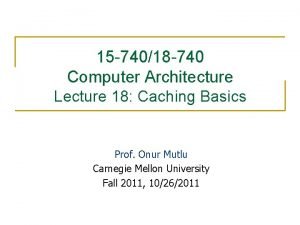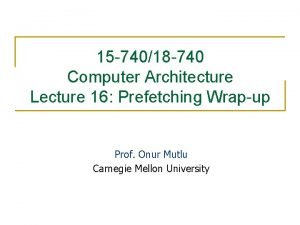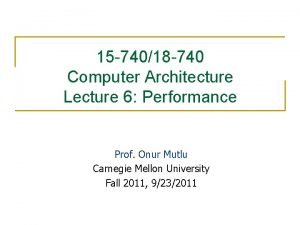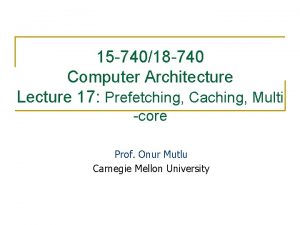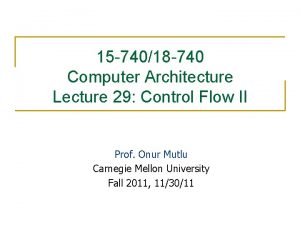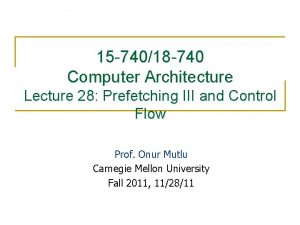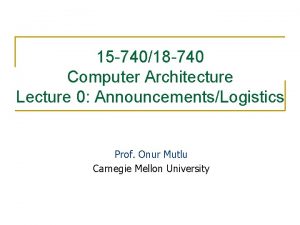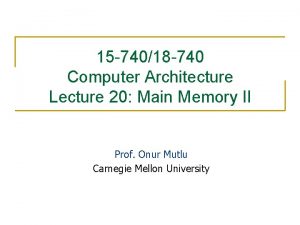15 74018 740 Computer Architecture Lecture 13 More
































- Slides: 32

15 -740/18 -740 Computer Architecture Lecture 13: More Caching Prof. Onur Mutlu Carnegie Mellon University

Announcements n Project Milestone I q n Due Monday, October 18 Paper Reviews q q q Jouppi, “Improving Direct-Mapped Cache Performance by the Addition of a Small Fully-Associative Cache and Prefetch Buffers, ” ISCA 1990. Qureshi et al. , “A Case for MLP-Aware Cache Replacement, “ ISCA 2006. Due Friday October 22 2

Last Time n n Handling writes Instruction vs. data Cache replacement policies Cache performance q n Cache size, associativity, block size Enhancements to improve cache performance q q q q Critical-word first, subblocking Replacement policy Hybrid replacement policies Cache miss classification Victim caches Hashing Pseudo-associativity 3

Today n More enhancements to improve cache performance Enabling multiple concurrent accesses Enabling high bandwidth caches n Prefetching n n 4

Cache Readings n Required: q q q n Hennessy and Patterson, Appendix C. 1 -C. 3 Jouppi, “Improving Direct-Mapped Cache Performance by the Addition of a Small Fully-Associative Cache and Prefetch Buffers, ” ISCA 1990. Qureshi et al. , “A Case for MLP-Aware Cache Replacement, “ ISCA 2006. Recommended: q q q Seznec, “A Case for Two-way Skewed Associative Caches, ” ISCA 1993. Chilimbi et al. , “Cache-conscious Structure Layout, ” PLDI 1999. Chilimbi et al. , “Cache-conscious Structure Definition, ” PLDI 1999. 5

Improving Cache “Performance” n Reducing miss rate q Caveat: reducing miss rate can reduce performance if more costly-to-refetch blocks are evicted n Reducing miss latency n Reducing hit latency 6

Improving Basic Cache Performance n Reducing miss rate q q More associativity Alternatives/enhancements to associativity n q n Victim caches, hashing, pseudo-associativity, skewed associativity Software approaches Reducing miss latency/cost q q q Multi-level caches Critical word first Subblocking Non-blocking caches Multiple accesses per cycle Software approaches 7

How to Reduce Each Miss Type n Compulsory q q n Caching cannot help Prefetching Conflict q q More associativity Other ways to get more associativity without making the cache associative n n Victim cache Hashing Software hints? Capacity q q Utilize cache space better: keep blocks that will be referenced Software management: divide working set such that each “phase” fits in cache 8

Victim Cache: Reducing Conflict Misses Direct Mapped Cache n n Victim cache Next Level Cache Jouppi, “Improving Direct-Mapped Cache Performance by the Addition of a Small Fully-Associative Cache and Prefetch Buffers, ” ISCA 1990. Idea: Use a small fully associative buffer (victim cache) to store evicted blocks + Can avoid ping ponging of cache blocks mapped to the same set (if two cache blocks continuously accessed in nearby time conflict with each other) -- Increases miss latency if accessed serially with L 2 9

Hashing and Pseudo-Associativity n Hashing: Better “randomizing” index functions + can reduce conflict misses n by distributing the accessed memory blocks more evenly to sets Example: stride where stride value equals cache size -- More complex to implement: can lengthen critical path q n Pseudo-associativity (Poor Man’s associative cache) q q Serial lookup: On a miss, use a different index function and access cache again Given a direct-mapped array with K cache blocks n n Implement K/N sets Given address Addr, sequentially look up: {0, Addr[lg(K/N)-1: 0]}, {1, Addr[lg(K/N)-1: 0]}, … , {N-1, Addr[lg(K/N)-1: 0]} 10

Skewed Associative Caches (I) n Basic 2 -way associative cache structure Way 1 Way 0 Same index function for each way =? Tag Index Byte in Block 11

Skewed Associative Caches (II) n Skewed associative caches q Each bank has a different index function Way 0 same index redistributed to different sets same index same set Way 1 f 0 =? tag index byte in block =? 12

Skewed Associative Caches (III) n n Idea: Reduce conflict misses by using different index functions for each cache way Benefit: indices are randomized q Less likely two blocks have same index n q n Reduced conflict misses May be able to reduce associativity Cost: additional latency of hash function 13

Improving Hit Rate via Software (I) n n Restructuring data layout Example: If column-major q q x[i+1, j] follows x[i, j] in memory x[i, j+1] is far away from x[i, j] Poor code for i = 1, rows for j = 1, columns sum = sum + x[i, j] n n This is called loop interchange Other optimizations can also increase hit rate q n Better code for j = 1, columns for i = 1, rows sum = sum + x[i, j] Loop fusion, array merging, … What if multiple arrays? Unknown array size at compile time? 14

More on Data Structure Layout struct Node { struct Node* node; int key; char [256] name; char [256] school; } while (node) { if (node key == input-key) { // access other fields of node } node = node next; } n n n Pointer based traversal (e. g. , of a linked list) Assume a huge linked list (1 M nodes) and unique keys Why does the code on the left have poor cache hit rate? q “Other fields” occupy most of the cache line even though rarely accessed! 15

How Do We Make This Cache. Friendly? struct Node { n Idea: separate frequentlystruct Node* node; int key; struct Node-data* node-data; used fields of a data structure and pack them into a separate data structure } struct Node-data { char [256] name; char [256] school; } while (node) { if (node key == input-key) { // access node-data } node = node next; } n Who should do this? q q Programmer Compiler n q q Profiling vs. dynamic Hardware? Who can determine what is frequently used? 16

Improving Hit Rate via Software (II) n Blocking q q q n Divide loops operating on arrays into computation chunks so that each chunk can hold its data in the cache Avoids cache conflicts between different chunks of computation Essentially: Divide the working set so that each piece fits in the cache But, there are still self-conflicts in a block 1. there can be conflicts among different arrays 2. array sizes may be unknown at compile/programming time 17

Improving Basic Cache Performance n Reducing miss rate q q More associativity Alternatives to associativity n q n Victim caches, hashing, pseudo-associativity, skewed associativity Software approaches Reducing miss latency/cost q q q Multi-level caches Critical word first Subblocking Multiple outstanding accesses (Non-blocking caches) Multiple accesses per cycle Software approaches 18

Handling Multiple Outstanding Accesses n Non-blocking or lockup-free caches q n n Kroft, “Lockup-Free Instruction Fetch/Prefetch Cache Organization, " ISCA 1981. Question: If the processor can generate multiple cache accesses, can the later accesses be handled while a previous miss is outstanding? Idea: Keep track of the status/data of misses that are being handled in Miss Status Handling Registers (MSHRs) q A cache access checks MSHRs to see if a miss to the same block is already pending. n n q If pending, a new request is not generated If pending and the needed data available, data forwarded to later load Requires buffering of outstanding miss requests 19

Non-Blocking Caches (and MLP) n n Enable cache access when there is a pending miss Enable multiple misses in parallel q Memory-level parallelism (MLP) n q generating and servicing multiple memory accesses in parallel Why generate multiple misses? parallel miss isolated miss A B C time n q Enables latency tolerance: overlaps latency of different misses How to generate multiple misses? n Out-of-order execution, multithreading, runahead, prefetching 20

Miss Status Handling Register n n Also called “miss buffer” Keeps track of q q n Outstanding cache misses Pending load/store accesses that refer to the missing cache block Fields of a single MSHR q q q Valid bit Cache block address (to match incoming accesses) Control/status bits (prefetch, issued to memory, which subblocks have arrived, etc) Data for each subblock For each pending load/store n Valid, type, data size, byte in block, destination register or store buffer entry address 21

Miss Status Handling Register 22

MSHR Operation n On a cache miss: q Search MSHR for a pending access to the same block n n Found: Allocate a load/store entry in the same MSHR entry Not found: Allocate a new MSHR No free entry: stall When a subblock returns from the next level in memory q Check which loads/stores waiting for it n n q q Forward data to the load/store unit Deallocate load/store entry in the MSHR entry Write subblock in cache or MSHR If last subblock, dellaocate MSHR (after writing the block in cache) 23

Non-Blocking Cache Implementation n When to access the MSHRs? q q n In parallel with the cache? After cache access is complete? MSHRs need not be on the critical path of hit requests q Which one below is the common case? n n Cache miss, MSHR hit Cache hit 24

Improving Basic Cache Performance n Reducing miss rate q q More associativity Alternatives/enhancements to associativity n q n Victim caches, hashing, pseudo-associativity, skewed associativity Software approaches Reducing miss latency/cost q q q Multi-level caches Critical word first Subblocking Non-blocking caches Multiple accesses per cycle Software approaches 25

Reducing Miss Cost/Latency via Software n Enabling more memory-level parallelism q q n Restructuring code Taking advantage of stall-on-use policy in hardware Inserting prefetch instructions 26

Enabling High Bandwidth Caches

Multiple Instructions per Cycle n n n Can generate multiple cache accesses per cycle How do we ensure the cache can handle multiple accesses in the same clock cycle? Solutions: q true multi-porting q virtual multi-porting (time sharing a port) q multiple cache copies q banking (interleaving) 28

Handling Multiple Accesses per Cycle (I) n True multiporting Each memory cell has multiple read or write ports + Truly concurrent accesses (no conflicts regardless of address) -- Expensive in terms of area, power, and delay q What about read and write to the same location at the same time? q n n Peripheral logic needs to handle this Virtual multiporting q q Time-share a single port Each access needs to be (significantly) shorter than clock cycle Used in Alpha 21264 Is this scalable? 29

Handling Multiple Accesses per Cycle n Multiple (II) cache copies q q n n Stores update both caches Loads proceed in parallel Used in Alpha 21164 Port 1 Load Scalability? q q Store operations form a bottleneck Area proportional to “ports” Cache Copy 1 Port 1 Data Store Port 2 Cache Copy 2 Port 2 Data Load 30

Handling Multiple Accesses per Cycle n Banking(III) (Interleaving) q Bits in address determines which bank an address maps to n n Address space partitioned into separate banks Which bits to use for “bank address”? + No increase in data store area -- Cannot always satisfy multiple accesses Why? -- Crossbar interconnect in input/output n Bank conflicts q q Two accesses are to the same bank How can these be reduced? n Bank 0: Even addresses Bank 1: Odd addresses Hardware? Software? 31

Evaluation of Design Options n Which alternative is better? q q q n true multi-porting virtual multi-porting (time sharing a port) multiple cache copies banking (interleaving) How do we answer this question? Simulation q q q See Juan et al. ’s evaluation of above options: “Data caches for superscalar processors, ” ICS 1997. What are the shortcomings of their evaluation? Can one do better with sole simulation? 32
 Lirik lagu more more more we praise you
Lirik lagu more more more we praise you More more more i want more more more more we praise you
More more more i want more more more more we praise you Computer architecture notes
Computer architecture notes Isa definition computer
Isa definition computer Asc 740
Asc 740 Sfas 109
Sfas 109 Deloitte asc 740
Deloitte asc 740 740
740 Asc 740-30-25-9
Asc 740-30-25-9 Prof. onur mutlu
Prof. onur mutlu Who wrote the ffa creed? when was it adopted?
Who wrote the ffa creed? when was it adopted? 14-740
14-740 F 740
F 740 R 740
R 740 Cs 740
Cs 740 01:640:244 lecture notes - lecture 15: plat, idah, farad
01:640:244 lecture notes - lecture 15: plat, idah, farad Bus design in computer architecture
Bus design in computer architecture Difference between organization and architecture
Difference between organization and architecture Design of a basic computer
Design of a basic computer Computer security 161 cryptocurrency lecture
Computer security 161 cryptocurrency lecture Computer aided drug design lecture notes
Computer aided drug design lecture notes 5 apples in a basket riddle
5 apples in a basket riddle The more you study the more you learn
The more you study the more you learn Aspire not to
Aspire not to Example of inertia
Example of inertia Knowing more remembering more
Knowing more remembering more The more i give to thee the more i have
The more i give to thee the more i have More choices more chances
More choices more chances Human history becomes more and more a race
Human history becomes more and more a race The architecture business cycle
The architecture business cycle Call and return architecture in software architecture
Call and return architecture in software architecture Integral product architecture example
Integral product architecture example Product architecture steps
Product architecture steps







